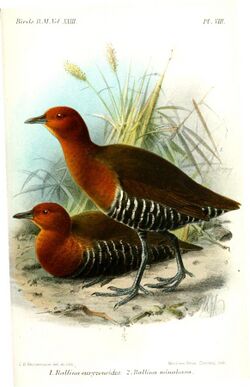Biology:Slaty-legged crake
| Slaty-legged crake | |
|---|---|

| |
| Rallina eurizonoides
Mangaon, Maharashtra, India | |
| Scientific classification | |
| Domain: | Eukaryota |
| Kingdom: | Animalia |
| Phylum: | Chordata |
| Class: | Aves |
| Order: | Gruiformes |
| Family: | Rallidae |
| Genus: | Rallina |
| Species: | R. eurizonoides
|
| Binomial name | |
| Rallina eurizonoides (Lafresnaye, 1845)
| |
| Synonyms | |
| |
The slaty-legged crake or banded crake (Rallina eurizonoides) is a waterbird in the rail and crake family, Rallidae.
Distribution and habitat
Its breeding habitat is swamps and similar wet areas in well-wooded country across south Asia east from India , Pakistan , and Sri Lanka to the Philippines and Indonesia. The rails are mainly permanent residents throughout their range, but some northern populations migrate further south in winter.
Description
The slaty-legged crake is about 25 cm long. Its body is flattened laterally to allow easier passage through the undergrowth. It has long toes and a short tail. Colouring includes a brown back, chestnut head and breast, and strong black-and-white barring on the flanks, belly and undertail. The throat is white, the bill is yellowish, and the legs are green. Sexes are similar; juveniles are dark brown above and below, although they have the belly barring and white throat.
Behaviour
Slaty-legged crakes are territorial, but are quite secretive, hiding in bushes when disturbed. They probe with their bill in mud or shallow water, also picking up food by sight. They forage for berries and insects on the ground, or clambering through bushes and undergrowth. They nest in a dry location on the ground or low bush usually near forest paths and forest streams, laying 4–8 eggs. A study conducted in Nilambur, Kerala in southern India shows that the incubation period was about 20 days.[2] full nest video with information is available on channel- Wild India by Sachin Main
References
- ↑ BirdLife International (2020). "Rallina eurizonoides". IUCN Red List of Threatened Species 2020: e.T22692317A181757127. doi:10.2305/IUCN.UK.2020-3.RLTS.T22692317A181757127.en. https://www.iucnredlist.org/species/22692317/181757127. Retrieved 12 November 2021.
- ↑ Murukesh M.D., Peroth Balakrishnan (2015). "On the breeding of the Slaty-legged Crake (Aves: Rallidae: Rallina eurizonoides) in Nilambur, Kerala, southern India". Journal of Threatened Taxa 7 (6): 7298–7301. doi:10.11609/jott.o4185.7298-301. http://www.threatenedtaxa.in/index.php/JoTT/article/view/2029/3249.
- Birds of India by Grimmett, Inskipp and Inskipp, ISBN:0-691-04910-6
Wikidata ☰ Q679123 entry
 |



